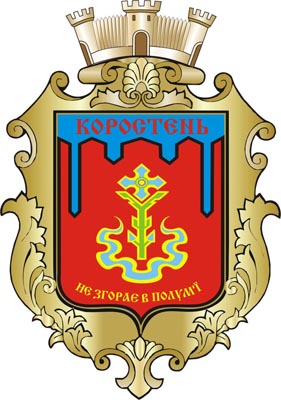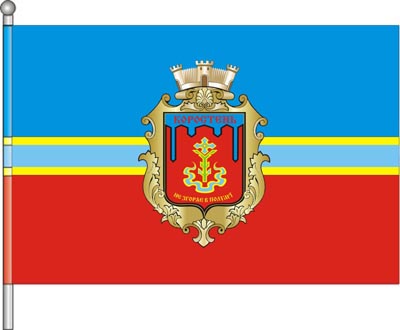Korosten is a city of regional subordination (Zhytomyr region), located on the Uzh River (a tributary of the Pripyat), at a distance of 87 km north of the regional center of the city of Zhytomyr, 150 km from the capital of Ukraine, Kyiv, and 60 km from the border with the Republic of Belarus. It borders Yemilchynskyi, Ovrutskyi, Luhynskyi, Malinskyi, Yemilchynskyi, Volodar-Volynskyi, Ovrutskyi, Narodytskyi districts. With an area of 3,385.1 hectares, it is the second largest city in the region after Zhytomyr.
Geography of the city of Korosten
Korosten is a city in the Zhytomyr region, the district center. It is located on the Uzh River at a distance of 150 km from the capital of Ukraine, Kyiv, 90 km from Zhytomyr and 60 km from the border with the Republic of Belarus. Korosten is a city of regional subordination, it has borders with Malynskyi, Luhynskyi, Volodar-Volynskyi, Narodnytskyi, Emilchynskyi and Ovrutskyi districts. Since 2020, as a result of decentralization, the mentioned districts have become part of the single Korosten district.
The area of the city is about 34 km², it is the second most populous city in the region. The geographic zone of the city is Polissia. Korosten has long been known to many scientists of the world. The Korosten pluton is one of the largest geological massifs of the Ukrainian continental geological shield. The Central Botanical District is named Korostensko-Zhytomyr.
Korosten is crossed by two international highways: Kyiv-Warsaw and Minsk-Izmail, Korosten station has 5 directions of train traffic on:
- Sarny,
- Shepetivka,
- Kyiv,
- Zhytomyr,
- Ovruch.
The mineral and raw material potential of the city and district is represented by a number of mineral deposits. These are decorative facing stone, marble, raw materials for metallurgy and construction industry, limestones, brown coal, peat. Granites known to the entire former Soviet Union are also mined, there are large deposits of titanium that meet the needs of Ukraine, apatites, zirconium, phosphorites.
The region is engaged in stone processing, granite crushed stone, sand from bran is produced. A significant part of facing materials (labradorite, granite, gabbro) of Ukraine, and about 90% of it is concentrated in the Korosten massif. A characteristic feature of these materials is their unique color scheme – blue, green, and sometimes golden colors. It is an excellent raw material for the production of marble chips, magnesium oxides, resins, dolomites for metallurgy, various types of fluxes and fillers, as well as mineral fertilizers.
The main water artery of the city is the Uzh River.
The region ranks first in Ukraine in terms of reserves of forest resources, coniferous species (60%), as well as hard-leaved (oak) and broad-leaved (birch, alder, aspen) species prevail.
Geographic coordinates of the country of Korosten: latitude: 50° 57′ 0″ N 50.95°, longitude: 28° 39′ 0″ E 28.65°.
The climate is rather mild – moderate, the air temperature rarely drops below -25 °C in winter, and no more than +35 °C in summer. The average annual air temperature is 6.9 °C, the lowest in January (-6.0 °C), the highest in July (+18.0 °C). On average, 600 mm of atmospheric precipitation falls in Korosten per year, the least in February, the most in July. The average relative humidity during the year is 78%, the lowest in May (68%), the highest in December (89%). Winds from the west and north-west are most frequent in the city, while winds from the north-east are the least frequent. The highest wind speed is in the cold period of the year, the lowest is in August. In January, it averages 4.6 m/s, in July – 3.4 m/s. The total number of days with thunderstorms per year is 20, with hail – 3, and with snow – 65.
Symbolism of Korosten
Coat of arms of the city of Korosten
 The new coat of arms of Korosten was developed taking into account the composition of the previous coat of arms. The old coat of arms of the city was a blue French shield, in the heart of which is a red shield, the main field of which is reserved for the image of the fortress wall in dark red. Against the background of the fortress wall, a green stalk of flax is depicted, which should symbolize the nature of Polissia, a four-stemmed red flower symbolizes the ancient fortifications, which were located on both sides of the Uzh River and protected each other. The blue Snake River with golden banks wraps around the flax flower. At the head of the shield is the name of the city of Korosten, separated from the middle shield by a golden strip. The shield and shield are framed with gold edging.
The new coat of arms of Korosten was developed taking into account the composition of the previous coat of arms. The old coat of arms of the city was a blue French shield, in the heart of which is a red shield, the main field of which is reserved for the image of the fortress wall in dark red. Against the background of the fortress wall, a green stalk of flax is depicted, which should symbolize the nature of Polissia, a four-stemmed red flower symbolizes the ancient fortifications, which were located on both sides of the Uzh River and protected each other. The blue Snake River with golden banks wraps around the flax flower. At the head of the shield is the name of the city of Korosten, separated from the middle shield by a golden strip. The shield and shield are framed with gold edging.
The new coat of arms repeats the basic composition of the old coat of arms, only the flax flower is blue and the field above the fortress wall is blue. The shield is framed by a cartouche adopted in the modern heraldry of Ukrainian cities and proposed to heraldists by O.B. Grechilo The cartouche is crowned with the city’s modernized golden three-towered crown, which was developed at the Ukrainian Academy of Heraldry V.V. Bolgovim and V.P. Chepakom The modernized heraldic crown has, instead of stone fortress walls, wooden ones, which were used during the times of the Drevlian principality.
In the blue field of the heraldic shield above the fortress wall, the name of the city KOROSTEN is written in Cyrillic. The motto “WON’T BURN IN FLAME” is written at the foot of the shield. According to the rules of heraldry, mottos on the coat of arms are inadmissible. But in the old version of the coat of arms of the city, there was the inscription “Korosten” at the head of the shield, therefore, as an exception, the motto is written in the coat of arms as a memory of the repeated revival from the ashes of the city of Korosten.
Flag of the city of Korosten
 The flag of Korosten was developed for the first time. It is a canvas with two horizontal stripes of the same width. The upper band is blue, the lower band is red. The strips are separated by a symbolic image of the Uzh River – a strip 0.16 times the width of the flag. The strip repeats the color scheme of the symbolic image of the river. The ratio of the width of the flag to its length is 2-3.
The flag of Korosten was developed for the first time. It is a canvas with two horizontal stripes of the same width. The upper band is blue, the lower band is red. The strips are separated by a symbolic image of the Uzh River – a strip 0.16 times the width of the flag. The strip repeats the color scheme of the symbolic image of the river. The ratio of the width of the flag to its length is 2-3.
The blue color of the field of the flag cloth symbolizes the greatness and beauty of the ancient city.
The red color of the field of the flag cloth symbolizes the bravery and courage of the Drevlyan defenders of the city in 946, when Princess Olga besieged Korosten, and the defenders of Korosten fortified district No. 5 in 1941 during the Great Patriotic War.
Anthem of the city of Korosten
Music by Oles Kolyada
Poems by Lilia Beh
From the origins of antiquity and the monolith,
Sanctified by ages, washed in blood,
Trampled by foreigners, tired of oppression,
Korosten towered over the world in greatness!
Chorus:
Glory! Glory to the Drevlyan people!
Glory to the land of our brave fathers.
Flowers! Bloom, like the decoration of the state,
The city of Korosten is the greatness and pride of the ages!
You endured the sore days of adversity,
And time did not overshadow the thorny years for us,
So Korosten was built in the new century
Out of love and joy freely and solemnly!
Chorus
In the region of Poliske, the city is a pearl,
Raise your buildings to the sky mightily,
Dear light at a good hour
Move forward, city of Korosten, to a better future!
Chorus
Population of Korosten

According to the 1989 census, the largest number of residents lived in Korosten since the city was founded: 77,000 residents. Currently, the population of Korosten is about 65,700 people. Of these, 38,800 people are of working age (from 16 to 55 years for women; from 16 to 60 years for men).
27,000 people are employed in all areas of the economic complex. The population is younger than working age – 11.3 thousand people, older than working age – 15.6 thousand people.
By nationality, the population of the city of Korosten is mainly Ukrainians and Russians, representatives of other nationalities also live in the city: Belarusians, Poles, Czechs, etc. Before the collapse of the Soviet Union, Jews made up a very large number, but many of them immigrated to their historical homeland.
Demographic indicators of the city of Korosten:
- Number of births: about 800 people;
- Number of dead: about 1,100 people;
- Natural reduction of the population: about -300 people.
It should be noted that the number of births increases every year, which leads to a decrease in the natural population decline in Korosten.
The annual birth rate in the city per 1,000 inhabitants is about 11%. The number of registered marriages during the year is about 600 new families, the number of divorces is about 300 units.
Come to our city of Korosten, create strong families and increase the birth rate of the glorious Drevlya region!
